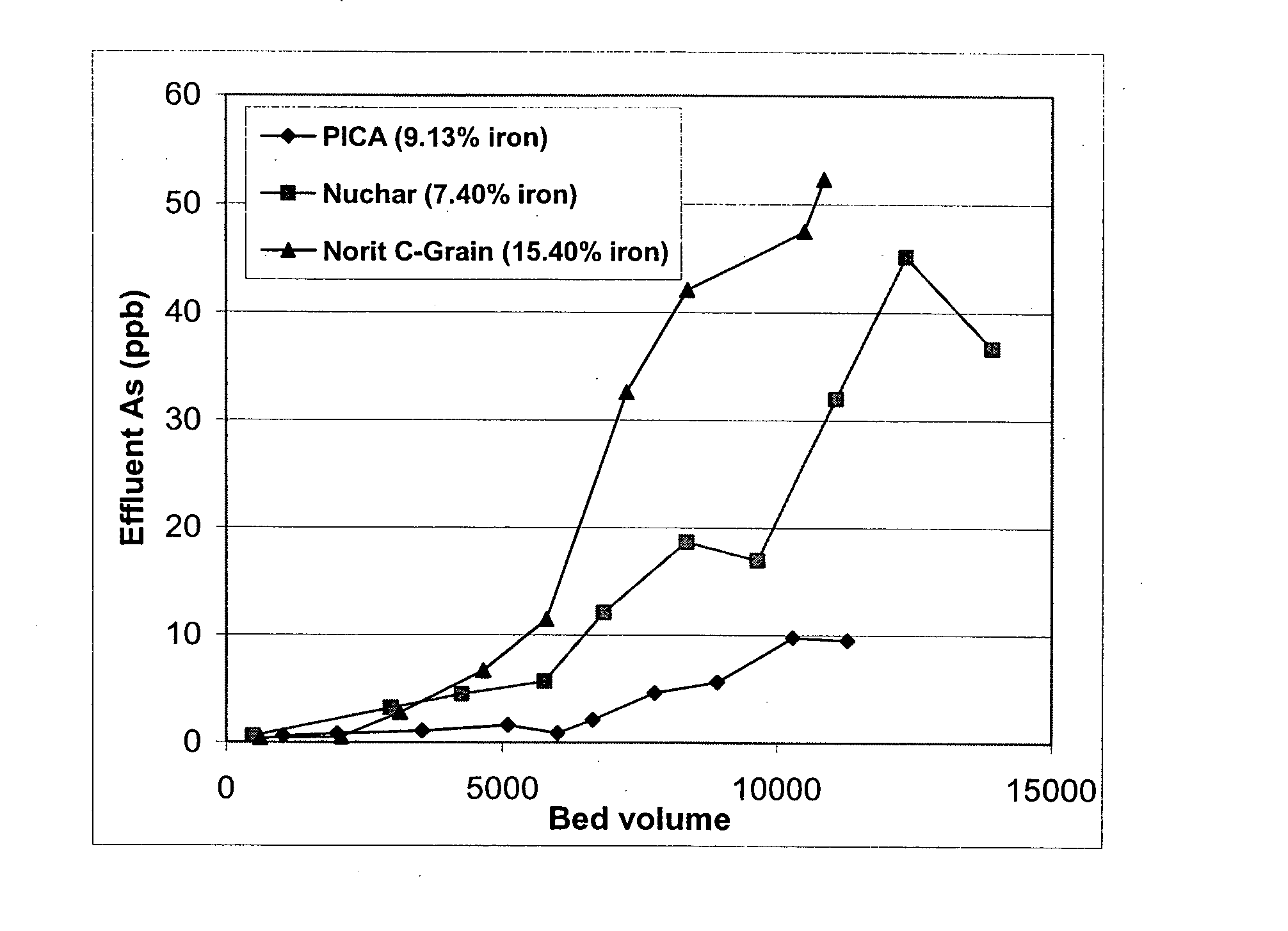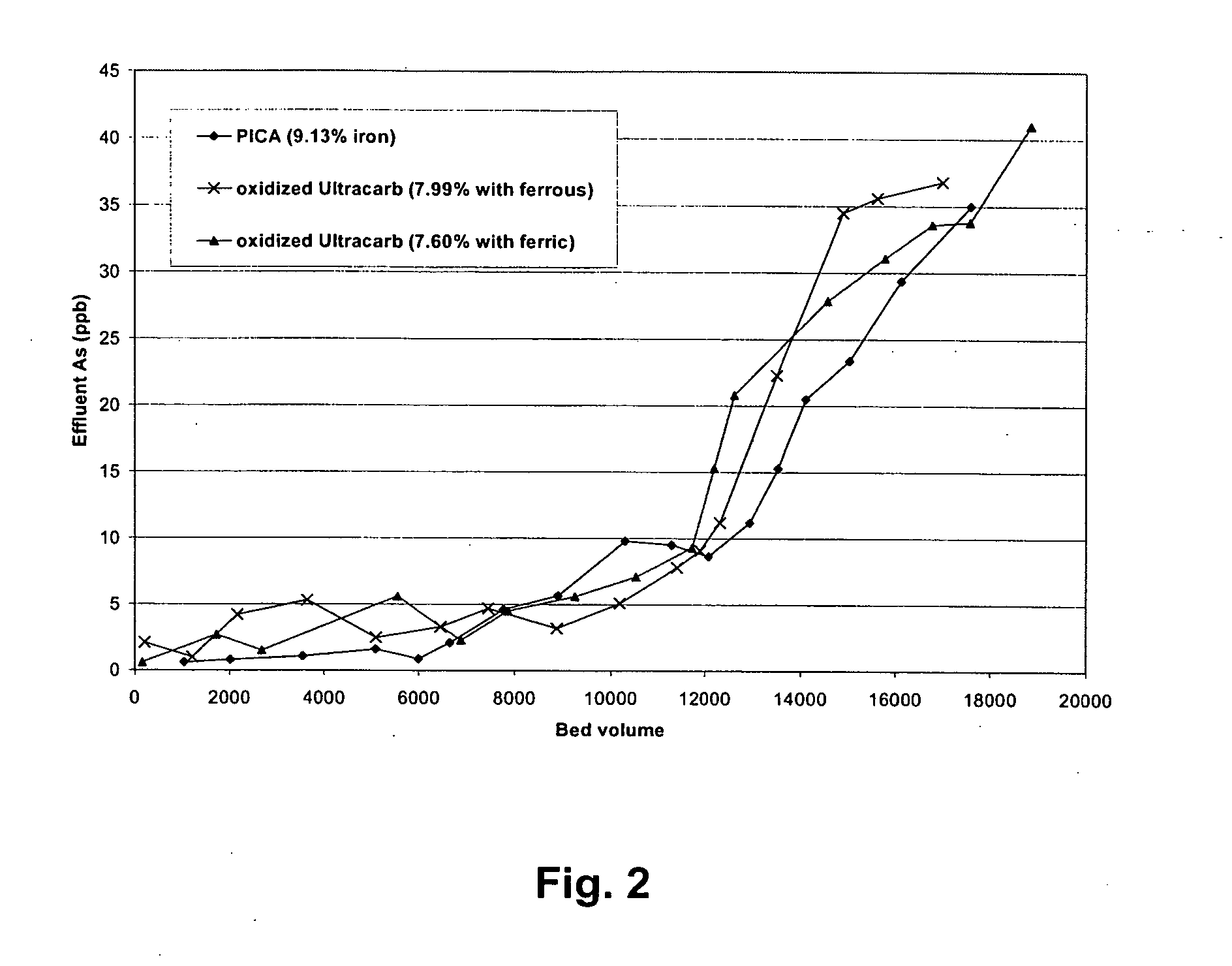Method for oxyanion removal from ground water
a technology of ground water and oxyanion, which is applied in the direction of water/sewage treatment by ion exchange, nuclear engineering, separation processes, etc., can solve the problems of significant amount of headloss pressure built up in the gfh system, perchlorate might adversely affect people's thyroid gland, etc., and achieve low capital, operating and energy costs , the effect of simple operation
- Summary
- Abstract
- Description
- Claims
- Application Information
AI Technical Summary
Benefits of technology
Problems solved by technology
Method used
Image
Examples
example 2
[0093] Rapid small-scale column tests were carried out with oxidized and then iron-loaded NORIT C-Grain, Nuchar and PICA carbons since those carbons had very high iron loading (7.4-15%). FIGS. 1 and 2 are the column test result for arsenic removal by those three carbons. Breakthrough bed volume was set as the bed volume of water passed through column until the As concentration from the effluent first reaches 10 ppb. FIG. 1 and 2 shows that oxidized PICA and Ultracarb carbon showed the highest capacity for arsenic removal.
example 3
[0094] The inventors also conducted tests to determine how much iron could be preloaded onto activated carbon when the iron was complexed with organic carboxyl species in the water phase be sorption into the activated carbon. We have hypothesized that because activated carbon has a high surface area, if we can cover this surface with a fine film of iron, then we can get the most efficient removal of arsenic, on the basis of pounds of iron required per pound of arsenic removed. Moreover, if we pre-loaded activated carbon with fatty acid or chelating agent-iron complexes, we could increase the GAC's capacity to adsorb iron, and hence arsenic. Citrate acid, L-Glutamic acid and EDTA were tested during the period. In addition, ferric ammonia citrate was used directly for iron loading instead of citric acid plus ferric chloride.
[0095] Two loading protocols were employed for iron loading:
[0096] (1) One-step protocol: A predetermined amount of carbon was added to a fatty acid or chelating...
example4
[0102] As shown in FIG. 3, isotherm results are illustrated. In these experiments, a prescribed amount of activated carbon (10-100 mg) was added to 50 mL arsenic-spiked Rutland groundwater (Total arsenic concentration is 550 ppb). The water pH had been adjusted to 6 with 0.1 M HCl. The mixtures were then put on the horizontal shaking table and shaken at 120-150 rpm for 48 hours. Then the resulting solution was analyzed for arsenic. The results fit with both Freudlich and Langmuir Isotherm; and the R2 value is slightly higher with Langmuir Isotherm. The highest qe value obtained is 1.8 mg / g, which was obtained at a Ce value of 178 ppb.
PUM
| Property | Measurement | Unit |
|---|---|---|
| pH | aaaaa | aaaaa |
| pH | aaaaa | aaaaa |
| temperature | aaaaa | aaaaa |
Abstract
Description
Claims
Application Information
 Login to View More
Login to View More - R&D
- Intellectual Property
- Life Sciences
- Materials
- Tech Scout
- Unparalleled Data Quality
- Higher Quality Content
- 60% Fewer Hallucinations
Browse by: Latest US Patents, China's latest patents, Technical Efficacy Thesaurus, Application Domain, Technology Topic, Popular Technical Reports.
© 2025 PatSnap. All rights reserved.Legal|Privacy policy|Modern Slavery Act Transparency Statement|Sitemap|About US| Contact US: help@patsnap.com



